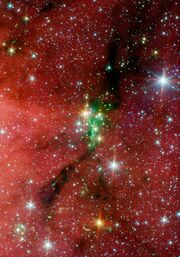Astronomy:Serpens South
| Serpens South | |
|---|---|
 A cluster of new stars called Serpens South. Courtesy of NASA/ESA | |
| Observation data (J2000.0 epoch) | |
| Constellation | Serpens |
| Right ascension | 18h 30m 03.00s[1] |
| Declination | −02° 01′ 58.2″[1] |
| Distance | 1422 ± 30 ly (436.0 ± 9.2 pc[2]) |
| Apparent dimensions (V) | 14.4 × 20.3 arcmins |
| Physical characteristics | |
| Radius | 3.5 × 5 ly |
The Serpens South star cluster[3] is a relatively dense group of more than 600 young stars, dozens of which are protostars just beginning to form.[4][5] The cluster is situated in the southern portion of the Serpens cloud (adjacent to the star-forming region known as W40). The stars are embedded in a dense filament of interstellar gas, which is part of the giant molecular cloud that has given rise to the cluster of young stars in W40. This entire complex is located at a distance of 1420 light-years (436 pc) from the Earth, and is approximately the same distance as the Serpens Main cluster.[2]
The cluster was uncovered by NASA's Spitzer Space Telescope.[3] This discovery was made possible by the infrared capabilities of this space telescope, which were necessary because the stars are completely obscured by interstellar dust in the Serpens cloud at visible wavelengths. Hundreds of young stellar objects have been detected at mid-infrared objects using these data.[6] X-ray observations by NASA's Chandra X-ray Observatory have also provided detailed information about the stellar cluster.[7][4] And, the region has served as a laboratory for radio-wavelength studies of star formation in dense molecular filaments.[8]
The discovery of Serpens South is a direct result of the Gould's Belt Legacy project at the Center for Astrophysics | Harvard & Smithsonian, which aims to study all prominent star-forming regions within about 1,600 light-years of Earth.[9][10] The Gould Belt is a ring of molecular clouds and associated star-forming regions first described by astronomer Benjamin Gould in 1879. Although the Serpens Molecular cloud is too distant to formally be considered a member of the Gould Belt, it is often included in Gould Belt surveys.[2]
Serpens South is located half a degree west of the main W40 cluster and three degrees south of the Serpens Main cluster.
See also
References
- ↑ 1.0 1.1 "NAME Serpens South Cluster". SIMBAD. Centre de données astronomiques de Strasbourg. http://simbad.u-strasbg.fr/simbad/sim-basic?Ident=NAME+Serpens+South+Cluster.
- ↑ 2.0 2.1 2.2 Ortiz-León, G. N. (2016). "The Gould's Belt Distances Survey (GOBELINS) III. The distance to the Serpens/Aquila Molecular Complex". The Astrophysical Journal 834 (2): 143. doi:10.3847/1538-4357/834/2/143. Bibcode: 2017ApJ...834..143O.
- ↑ 3.0 3.1 Gutermuth, R. A.; Bourke, T. L.; Allen, L. E.; Myers, P. C.; Megeath, S. T.; Matthews, B. C.; Jørgensen, J. K.; Di Francesco, J. et al. (2008). "TheSpitzerGould Belt Survey of Large Nearby Interstellar Clouds: Discovery of a Dense Embedded Cluster in the Serpens-Aquila Rift". The Astrophysical Journal 673 (2): L151–L154. doi:10.1086/528710. ISSN 0004-637X. Bibcode: 2008ApJ...673L.151G.
- ↑ 4.0 4.1 Getman (2016). "Star Formation In Nearby Clouds (SFiNCs): X-ray And Infrared Source Catalogs And Membership". The Astrophysical Journal Supplement Series 229 (2): 28. doi:10.3847/1538-4365/229/2/28. Bibcode: 2017ApJS..229...28G.
- ↑ Maury, A. J.; André, P.; Men'shchikov, A.; Könyves, V.; Bontemps, S. (2011). "The formation of active protoclusters in the Aquila rift: a millimeter continuum view". Astronomy & Astrophysics 535: A77. doi:10.1051/0004-6361/201117132. ISSN 0004-6361. Bibcode: 2011A&A...535A..77M.
- ↑ Povich, Matthew S.; Kuhn, Michael A.; Getman, Konstantin V.; Busk, Heather A.; Feigelson, Eric D.; Broos, Patrick S.; Townsley, Leisa K.; King, Robert R. et al. (2013). "THE MYStIX INFRARED-EXCESS SOURCE CATALOG". The Astrophysical Journal Supplement Series 209 (2): 31. doi:10.1088/0067-0049/209/2/31. ISSN 0067-0049. Bibcode: 2013ApJS..209...31P.
- ↑ Winston, E. (2009). "A Chandra Snapshot of Serpens South". Chandra Proposal: 11200492. Bibcode: 2009cxo..prop.2775W.
- ↑ Kirk, H. (2013). "Filamentary Accretion Flows in the Embedded Serpens South Protocluster". Astrophysical Journal 766 (2): 115. doi:10.1088/0004-637X/766/2/115. Bibcode: 2013ApJ...766..115K.
- ↑ Two Telescopes Combine to Probe Young 'Family' of Stars
- ↑ Mission statement - Gould's Belt Survey
External links
- The Spitzer Space Telescope
- The Harvard-Smithsonian Center for Astrophysics homepage
- The Gould's Belt Survey
Coordinates: ![]() 18h 30m 03.0s, −02° 01′ 58″
18h 30m 03.0s, −02° 01′ 58″
 |


